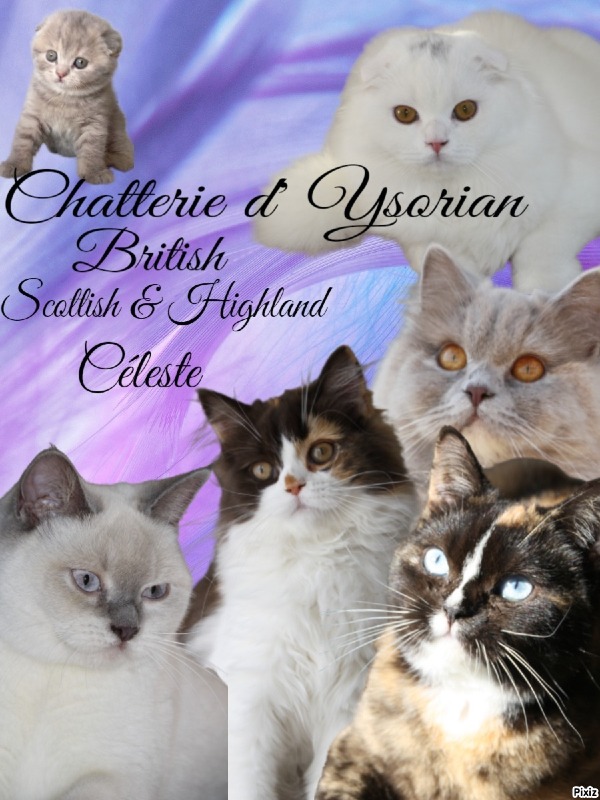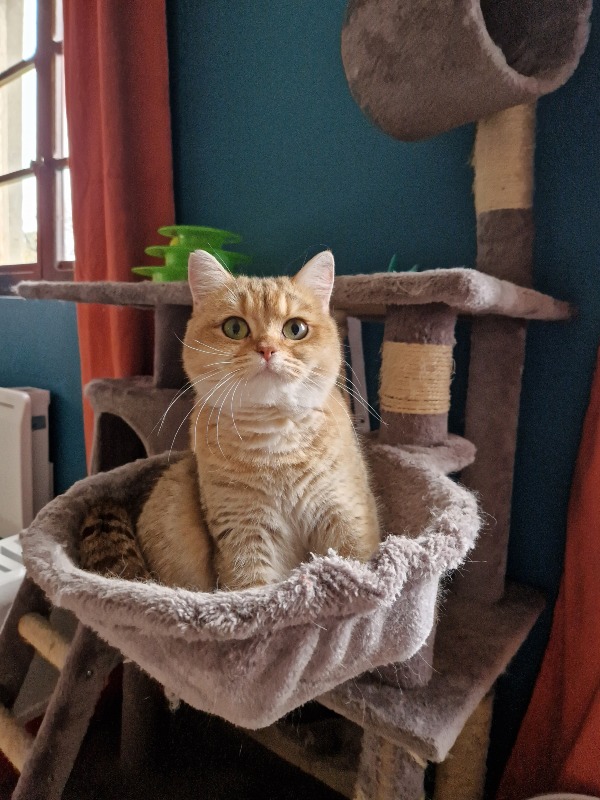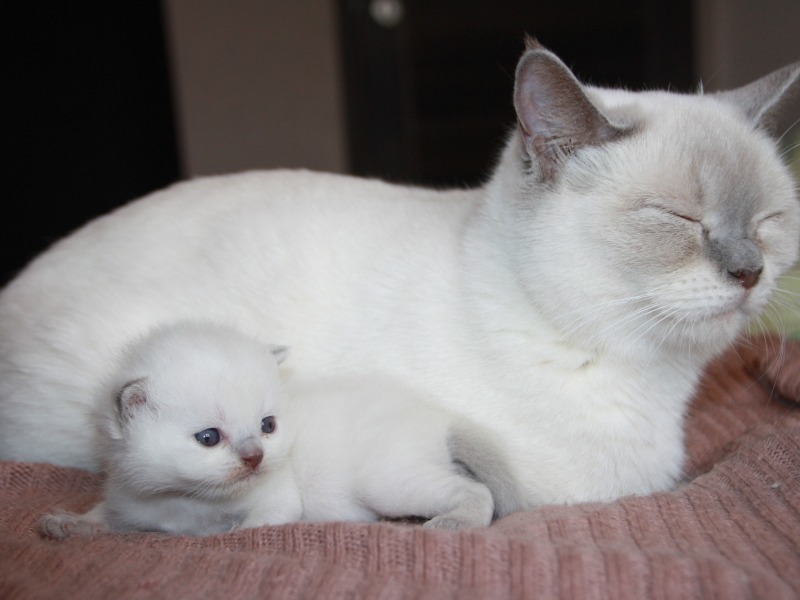British shorthair
Welcome to our page dedicated to the breed of cat british shorthair!
Here, you will find all the useful information about british shorthair. This descriptive profile will allow you to discover the aspects of this breed. You can notably consult information about the average price, monthly and annual upkeep expenses, their health, name ideas, as well as their official recognition by competent authorities.
Explore this page to discover everything you need to know.
Overall description of the breed
The British Shorthair is one of the most iconic and beloved cat breeds in the world. Its history goes back several centuries and its origins are deeply rooted in the history of the United Kingdom.
The British Shorthair's ancestors were probably domestic cats introduced to Britain by the Romans over two thousand years ago. Over time, these cats acclimatised to the British climate and developed distinctive characteristics to survive in their environment.
Over the following centuries, these short-haired cats continued to evolve and breed freely with other British felines. However, it wasn't until the 19th century that breeders began to take an interest in preserving and improving the breed.
The ancestors of the British Shorthair are Britain's native domestic cats, which developed naturally over time. Occasional cross-breeding with other breeds of shorthair could also have influenced the development of the breed.
The British Shorthair is a medium to large cat, well muscled and compact. Their body is powerful and rounded, with a broad chest and robust shoulders. They have strong bones, giving them a robust, powerful appearance.
The British Shorthair's head is broad and round, with full cheeks and a powerful jaw. Their large, round eyes are wide-set and expressive, generally copper, gold or green in colour to match their coat.
The coat is short, dense and glossy, with a thick undercoat to protect it from the elements. The variety of coat colours is vast, ranging from solid colours (blue, black, cream, etc.) to patterns (tabby, tortoiseshell, etc.).
This domestic feline is renowned for its calm, balanced and independent character. It is a cat that appreciates tranquillity and can be reserved with strangers, but it is also affectionate and attached to its owners. It is not very talkative, but expresses its affection through glances and purrs.
This cat is renowned for its patience and tolerance of children and other pets. Its calm nature makes it an excellent companion for people living in flats or urban environments.
The average weight of the British Shorthair is between 4kg and 7kg (9lb and 15lb), with males generally being larger and heavier than females. In terms of height, the average British Shorthair measures between 30 and 35 cm (12 to 14 inches) at the withers.
The founding breed club of the British Shorthair is the Governing Council of the Cat Fancy (GCCF), founded in 1910 in the United Kingdom. This club was at the forefront of the recognition and promotion of this iconic breed.
Its standard has been established over time, and the breed is now widely recognised and appreciated around the world by international cat organisations such as the Fédération Internationale Féline (FIFe), the Cat Fanciers' Association (CFA) and the World Cat Federation (WCF).
In conclusion, the British Shorthair is an elegant and endearing cat breed that has captured the hearts of many cat lovers around the world. Its rich history, balanced character and distinctive morphology make it one of the most popular and best-loved cats on the international cat scene.
Awareness of acquiring an animal
Each animal is a sensitive being, deserving love, attention and care.
When you choose to adopt an animal, you take on the responsibility of ensuring its health and well-being throughout its life.
To learn more about animal welfare, we invite you to consult our FAQ by clicking the button below:
Origins
The British Shorthair is a cat breed originating from Great Britain. Its ancestors are European domestic cats brought by the Romans during the invasion of the island. These cats mixed with the local populations, giving birth to sturdy felines adapted to the British climate. In the 19th century, British breeders began selecting these cats for their distinctive characteristics, thus creating the British Shorthair we know today. The breed was officially recognized at the end of the 19th century. The breeding work has allowed to fix the characteristic traits of the breed, including its majestic appearance and balanced temperament.
History
The history of the British Shorthair dates back to Roman times. After the introduction of cats by the Romans, these felines adapted to local conditions and evolved to become a robust and resistant breed. In the 19th century, British breeders began standardizing the breed by selecting the best specimens for their appearance and temperament. The first cat show in which the British Shorthair participated was held in 1871 at the Crystal Palace in London. After World War II, the breed almost disappeared due to crossings with other breeds to maintain genetic diversity. However, the efforts of breeders have allowed the British Shorthair to be restored to its full splendor. Today, it is one of the most popular and recognized cats worldwide.
Standard
The standard of the British Shorthair breed is defined by several distinctive characteristics. It should have a wide and round head with full cheeks, a short and straight nose, and small rounded ears. The eyes are large, round, and can vary in color depending on the coat. The body is medium to large in size, robust, muscular, with a broad chest and strong, thick legs. The tail is thick at the base, tapering slightly towards a rounded end. The fur should be short, dense, and uniform, giving a plush impression. Colors and patterns can vary, including blue, lilac, black, white, and many others.
Physical characteristics
The British Shorthair is a medium to large sized cat. Males generally weigh between 5 and 8 kg, while females weigh between 4 and 6 kg. Their body is muscular and stocky, with a broad chest and strong legs. The head is wide and round, with full cheeks, especially in adult males. The nose is short and straight, and the ears are small and rounded. The eyes are large and round, often copper in blue cats, but can be of different colors depending on the coat. Their coat is short, dense, and soft to the touch, resembling velvet. Coat colors include blue, lilac, cream, chocolate, black, white, as well as tabby and bicolor variations.
Character
The British Shorthair is known for its gentle and balanced temperament. It is a calm, patient, and generally reserved cat, but can also be very affectionate with its loved ones. It enjoys human company, but also appreciates its independence. This cat is known for its high tolerance and adapts well to different environments, making it an excellent companion for families with children or other animals. It is not particularly vocal and prefers to silently observe its surroundings. Intelligent and curious, the British Shorthair can be playful but often remains quiet, enjoying moments of rest on a comfortable couch. Its gentle and placid nature makes it an easy-going cat to live with on a daily basis.
Life expectancy
The British Shorthair has an average life expectancy of 12 to 20 years, which is relatively long for a cat breed. This longevity is the result of its natural robustness and low rate of hereditary diseases. To ensure a long and healthy life for your British Shorthair, it is essential to provide them with a balanced diet, regular veterinary care, and a stimulating and safe environment. Annual health check-ups, vaccinations, and preventive treatments against parasites are also essential to prevent common health problems. With proper attention to its well-being, a British Shorthair can enjoy a long and happy life with its family.
Exercise and activity needs
The British Shorthair is not particularly active, but still needs exercise to stay healthy and avoid obesity. Daily play sessions with interactive toys, balls, or feather teasers can help stimulate its mind and body. Although not a great climber, it will enjoy multi-level structures or cat trees to rest and observe its surroundings. Encouraging activities like toy hunting or hide and seek games can also be beneficial. It is important to note that this cat may tend to be lazy, so additional motivation from its owner may be needed to encourage it to move.
Recommended diet
The British Shorthair needs a balanced diet tailored to its age, weight, and activity level. High-quality food rich in animal proteins is recommended to maintain its muscle mass. It is important to control portions to prevent obesity, which can be a problem for this breed. Specific kibble for British Shorthair cats or food formulated for large cats can be beneficial. The monthly cost of feeding a British Shorthair ranges from 30 to 50 euros, depending on the quality of the products and the individual needs of the cat. It is also advisable to provide plenty of fresh water and limit treats.
Training and obedience
The British Shorthair is an intelligent cat and can be trained to perform certain simple tasks such as using a litter box or a scratcher. However, patience and consistency are required in training. Training sessions should be short and positive, using rewards such as treats or pets to reinforce desired behaviors. It is important to start training at a young age to establish good habits. Due to their calm nature, British Shorthairs respond well to a gentle and respectful approach. While they can learn simple tricks, they are not as receptive to complex training as some other more active cat breeds.
Behavior with children
The British Shorthair is generally very kind with children. Its gentle and patient nature makes it suitable to live with young children, as long as they are respectful and calm with him. It enjoys participating in family activities and can become a loyal playmate. However, it is essential to teach children to interact appropriately with the cat, avoiding sudden movements or overly intense games. The British Shorthair is tolerant, but also appreciates moments of tranquility. Supervising the initial interactions between the cat and children can help establish a harmonious and safe relationship for everyone.
Compatibility with Other Animals
The British Shorthair is known for being compatible with other pets, including dogs and cats. Their placid and tolerant nature allows for harmonious cohabitation, especially when introduced to new companions gradually and in a controlled manner. Initial meetings should be supervised and take place in a calm environment to avoid stress. British Shorthairs are generally non-aggressive and can get along with calm and friendly dogs. With other cats, they can form strong bonds, especially if raised together from a young age. The key is to ensure that each animal has enough space and attention to prevent conflicts.
Grooming needs
The British Shorthair has a short and dense coat that requires regular maintenance to remain healthy. Weekly brushing is sufficient to remove dead hair and reduce hairballs. During shedding periods, in spring and autumn, more frequent brushing may be necessary. In addition to brushing, it is important to check and clean the ears, trim the claws regularly, and monitor dental hygiene by providing chew toys or using specific dental products for cats. The British Shorthair is generally clean and takes care of its coat, but human assistance is always beneficial to maintain its impeccable appearance.
Health
The British Shorthair is a robust breed with few hereditary health problems. However, like all cats, they can be prone to certain conditions. Hypertrophic cardiomyopathy (HCM) is a heart disease to watch out for, and regular tests at the vet can help detect it early. They may also be prone to gingivitis and urinary stones, requiring dental checks and appropriate diets. Vaccinations, regular parasite treatments, and annual vet visits are essential to maintain their good health. With proper care, the British Shorthair can live a long and healthy life, often up to 15 years or more.
Average price
The average price of a British Shorthair can vary depending on several factors, including lineage, pedigree, and breeder reputation. In France, a British Shorthair kitten can cost between 800 and 1,500 euros. Kittens from award-winning lineages or intended for breeding can reach even higher prices, often beyond 2,000 euros. It is essential to choose a reputable breeder who tests their breeders for hereditary diseases and offers health guarantees. Initial acquisition costs may seem high, but they often reflect the care and attention given to breeding healthy and well-socialized cats.
Expenses
Monthly expenses for a British Shorthair include food, veterinary care, grooming products, and accessories such as litter and toys. On average, between 50 and 100 euros per month should be budgeted. Quality nutrition is a significant part of this budget, costing an average of 30 to 50 euros. Preventive veterinary care, such as vaccinations and antiparasitic treatments, can add variable costs. Grooming expenses are generally low, but accessories and toys to stimulate and entertain the cat can also be added to the budget. It is important to have an emergency fund for unforeseen veterinary care.
Name ideas
Choosing a name for a British Shorthair can be fun and inspiring. Here are some suggestions: Oliver, Bella, Milo, Luna, Leo, Sophie, Max, Chloe, Charlie, Daisy, Jack, Lily, Oscar, Ruby, Felix, Jasper, Nala, Simba, Cleo, Smokey, George, Poppy, Archie, Misty, Alfie, Willow, Theo, Rosie, Merlin, Tigger. These names perfectly suit the dignity and grace of the British Shorthair, while reflecting their gentle and affectionate nature. Whether you prefer classic, modern, or even names inspired by popular culture, it is important to choose a name that matches your cat's unique personality.
Legislation and regulation
The British Shorthair is not subject to specific regulations in terms of legislation. In France, as in many other countries, it is mandatory to identify cats with a microchip or tattoo and register them in a national database. Sterilization is recommended for pet cats to control the feline population and prevent unwanted litters. Breeders must comply with current regulations regarding the conditions of animal housing and breeding practices. There is no specific classification for the British Shorthair, but it is important to inquire about local laws regarding the ownership and transport of pets.
Official recognition
The British Shorthair is recognized by several international feline organizations. Among them, the International Feline Federation (FIFe), the Cat Fanciers’ Association (CFA), and The International Cat Association (TICA). In France, the LOOF (Livre Officiel des Origines Félines) also recognizes this breed and maintains the pedigree registry. Each organization has its own standards for the breed, but all recognize the distinctive traits of the British Shorthair. This recognition allows breeders to participate in feline exhibitions and promote the characteristics of the breed worldwide. The British Shorthair enjoys great popularity and international recognition for its beauty and temperament.
Pedigrees
Pedigrees available for the British Shorthair are maintained by several recognized breed clubs worldwide. In France, the LOOF (Official Book of Feline Origins) manages pedigrees and organizes feline exhibitions. In the United States, the Cat Fanciers' Association (CFA) and The International Cat Association (TICA) are the main organizations that issue pedigrees for this breed. In Europe, the International Feline Federation (FIFe) plays a similar role. Each breed club has its own selection and certification criteria, ensuring that registered cats meet the breed standards. These pedigrees ensure that British Shorthairs come from quality lines, with particular attention to health and physical and behavioral characteristics.
Destination and usage
The British Shorthair is primarily intended to be a companion animal due to its gentle and affectionate nature. Its calm and tolerant nature makes it an excellent companion for families, the elderly, and even young children. It is also appreciated for its beauty and often participates in cat shows, where it is judged on its physical characteristics and temperament. Although less active than some other breeds, the British Shorthair can also be used in animal therapy programs, providing comfort and companionship to those in need. In summary, it is versatile and adapts well to various roles, mainly focusing on companionship and human interaction.
Prohibitions
There are no specific restrictions regarding the possession or breeding of British Shorthair in most countries. However, it is important to respect local laws on animal welfare and regulations regarding breeding and selling cats. For example, in France, breeders must follow the guidelines of LOOF and ensure appropriate living conditions for their animals. Additionally, some regions may have restrictions on the number of cats one can own or rules regarding the sterilization of pets. It is always recommended to check local and national laws to ensure compliance with the possession and breeding of British Shorthair.
Breeders of British shorthair
Want to see more breeders of British shorthair?
Check out the page of our directory listing all breeders of British shorthairClassified Ads of British shorthair
Want to see more ads of British shorthair?
Check out the page listing all the ads of British shorthairBreed clubs of british shorthair
No of british shorthair breed clubs are currently registered on Preeders.
If you would like to highlight your breed club, sign up for free now and be the first to appear on this page.






